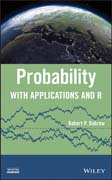
An introduction to probability at the undergraduate level Chance and randomness are encountered on a daily basis. Authored by a highly qualified professor in the field, Probability: With Applications and R delves into the theories and applications essential to obtaining a thorough understanding of probability. With real–life examples and thoughtful exercises from fields as diverse as biology, computer science, cryptology, ecology, public health, and sports, the book is accessible for a variety of readers. The book’s emphasis on simulation through the use of the popular R software language clarifies and illustrates key computational and theoretical results. Probability: With Applications and R helps readers develop problem–solving skills and delivers an appropriate mix of theory and application. The book includes: Chapters covering first principles, conditional probability, independent trials, random variables, discrete distributions, continuous probability, continuous distributions, conditional distribution, and limits An early introduction to random variables and Monte Carlo simulation and an emphasis on conditional probability, conditioning, and developing probabilistic intuition An R tutorial with example script files Many classic and historical problems of probability as well as nontraditional material, such as Benford’s law, power–law distributions, and Bayesian statistics A topics section with suitable material for projects and explorations, such as random walk on graphs, Markov chains, and Markov chain Monte Carlo Chapter–by–chapter summaries and hundreds of practical exercises Probability: With Applications and R is an ideal text for a beginning course in probability at the undergraduate level. INDICE: Preface xiii Acknowledgments xvii Introduction xix 1 First Principles 1 1.1 Random experiment, sample space, event 1 1.2 What is a probability? 3 1.3 Probability function 4 1.4 Properties of probabilities 7 1.5 Equally likely outcomes 10 1.6 Counting I 12 1.7 Problem solving strategies: complements, inclusion exclusion 15 1.8 Random variables 19 1.9 A closer look at random variables 22 1.10 A first look at simulation 23 1.11 Chapter summary 27 Exercises 29 2 Conditional Probability 35 2.1 Conditional probability 35 2.2 New information changes the sample space 40 2.3 Finding P(A and B) 42 2.4 Conditioning and the law of total probability 50 2.5 Bayes formula and inverting a conditional probability 57 2.6 Chapter summary 63 Exercises 64 3 Independence and Independent Trials 69 3.1 Independence and dependence 69 3.2 Independent random variables 77 3.3 Bernoulli sequences 79 3.4 Counting II 81 3.5 Binomial distribution 90 3.6 Stirling’s approximation 98 3.7 Poisson distribution 98 3.8 Product spaces? 108 3.9 Chapter summary 110 Exercises 112 4 Random Variables 121 4.1 Expectation 123 4.2 Functions of random variables 125 4.3 Joint distributions 130 4.4 Independent random variables 135 4.5 Linearity of expectation 140 4.6 Variance and standard deviation 145 4.7 Covariance and correlation 154 4.8 Conditional distribution 161 4.9 Properties of covariance and correlation? 167 4.10 Expectation of a function of a random variable? 169 4.11 Chapter summary 171 Exercises 174 5 A Bounty of Discrete Distributions 181 5.1 Geometric distribution 181 5.2 Negative binomial—up from the geometric 189 5.3 Hypergeometric—sampling without replacement 195 5.4 From binomial to multinomial 199 5.5 Benford’s law 206 5.6 Chapter summary 209 Exercises 211 6 Continuous Probability 217 6.1 Probability density function 219 6.2 Cumulative distribution function 223 6.3 Uniform distribution 226 6.4 Expectation and variance 228 6.5 Exponential distribution 230 6.6 Functions of random variables I 235 6.7 Joint distributions 242 6.8 Independence 250 6.8.1 Acceptreject method 253 6.9 Covariance, correlation 256 6.10 Functions of random variables II 258 6.11 Geometric probability 264 6.12 Chapter summary 271 Exercises 275 7 Continuous Distributions 283 7.1 Normal distribution 283 7.2 Gamma distribution 299 7.3 Poisson process 305 7.4 Beta distribution 314 7.5 Pareto distribution, power laws and the 8020 rule 318 7.6 Chapter summary 322 Exercises 325 8 Conditional distribution, expectation, variance 331 8.1 Conditional distributions 331 8.2 Discrete and continuous—mixing it up 338 8.3 Conditional expectation 342 8.4 Computing probabilities by conditioning 352 8.5 Conditional variance 355 8.6 Chapter summary 362 Exercises 364 9 Limits 369 9.1 Weak law of large numbers 371 9.2 Strong law of large numbers 377 9.3 Monte Carlo integration 382 9.4 Central limit theorem 386 9.5 Moment generating functions 395 9.6 Chapter summary 402 Exercises 404 10 Additional Topics 411 10.1 Bivariate normal distribution 411 10.2 Transformations of two random variables 419 10.3 Method of moments 423 10.4 Random walk on graphs 425 10.5 Random walks on weighted graphs and Markov chains 433 10.6 From Markov chain to Markov chain Monte Carlo 440 10.7 Chapter summary 452 Exercises 455 Appendix 460 A Getting started with R 461 B Probability distributions in R 471 C Summary of probability distributions 473 D Reminders from algebra and calculus 475 E More problems for practice 477 Problem Solutions 483 Bibliography 500 References 501 Index 504 Index 505
- ISBN: 978-1-118-24125-7
- Editorial: Wiley–Blackwell
- Encuadernacion: Cartoné
- Páginas: 520
- Fecha Publicación: 29/11/2013
- Nº Volúmenes: 1
- Idioma: Inglés
